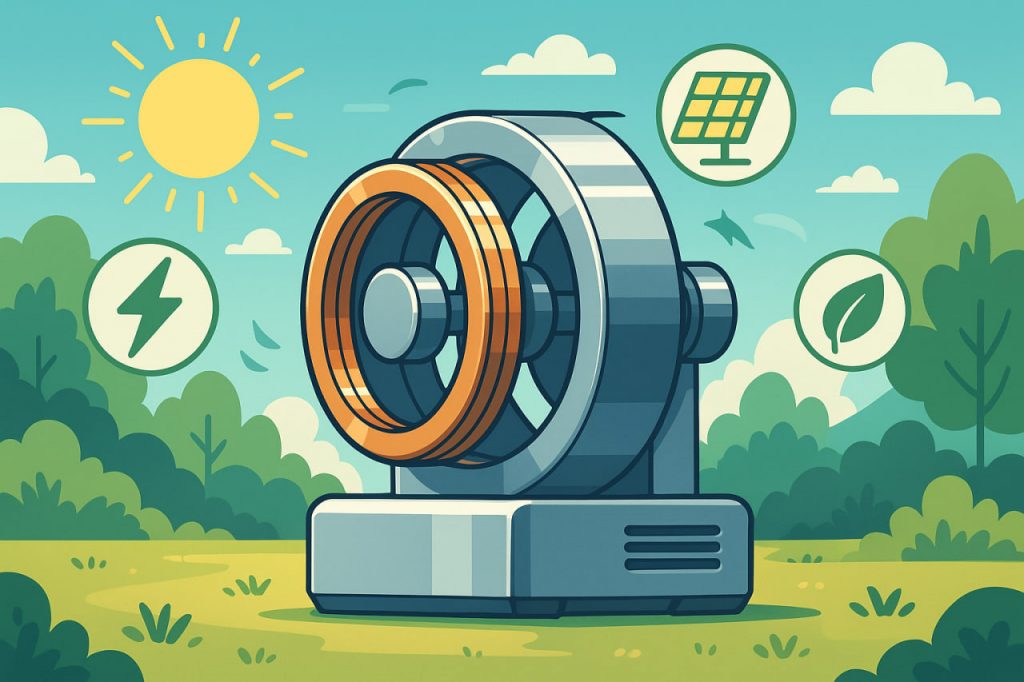In a world facing energy shortages and environmental challenges, the idea of fuel-free generators has captured the imagination of engineers and scientists alike. These devices promise to produce electricity without burning fossil fuels — reducing carbon emissions and dependence on oil or gas. While once considered impossible, advances in magnetic systems, piezoelectricity, thermoelectric converters, and renewable energy integration are bringing this vision closer to reality.
The Concept of a Fuel-Free Generator
A fuel-free generator (also known as a self-sustaining energy system) refers to a device that can generate electrical power without consuming traditional fuels such as gasoline, diesel, or natural gas. Instead, it relies on natural physical processes, electromagnetic induction, motion, or environmental energy sources like temperature differences and vibrations.
These systems are not “perpetual motion machines” — which violate the laws of physics — but rather advanced mechanisms that harvest existing energy more efficiently from the environment.
Modern Types of Fuel-Free Generators
Recent scientific progress has led to several working prototypes and experimental designs that show real promise for the future of clean, decentralized power generation.
1. Magnetic Generators
Magnetic generators use the interaction between permanent magnets and coils to induce electrical current. By strategically arranging magnetic fields, energy is produced with minimal mechanical resistance.
Modern systems, like the Bedini motor and Lutec generator, operate based on electromagnetic resonance, achieving high efficiency with very little external input.
2. Piezoelectric Generators
These devices convert mechanical vibrations or pressure into electricity using piezoelectric crystals. When bent or compressed, these crystals generate voltage. Such systems are being tested in smart roads, footwear, and industrial floors to recover energy from human or vehicle movement.
3. Thermoelectric and Atmospheric Energy Converters
Thermoelectric generators (TEGs) produce electricity from temperature differences between two materials. This principle is already used in spacecraft and remote monitoring stations.
Similarly, atmospheric energy devices capture static electricity and ionized particles from the air — an idea inspired by Nikola Tesla’s early experiments. Modern designs use high-voltage capacitors and nanomaterials to safely store and transform atmospheric energy into usable power.
4. Solar-Magnetic Hybrid Systems
Some new prototypes combine solar panels with magnetic or mechanical systems to store excess energy and reuse it even at night. By merging multiple renewable sources, these hybrids provide more stable and continuous output.
Recent Research and Innovations
Over the past decade, numerous research institutions and independent inventors have worked toward practical, fuel-free energy solutions.
- Japan’s Tokyo Institute of Technology developed a hybrid thermomagnetic generator that converts waste heat into electricity.
- German startups are experimenting with zero-fuel home generators that operate using earth’s natural magnetic field fluctuations.
- NASA continues research on deep-space thermoelectric generators that can function for decades without fuel.
While most of these technologies are still in prototype stages, they demonstrate that fuel-free energy is scientifically plausible and technologically attainable.
Advantages of Fuel-Free Generators
- Zero emissions: No carbon dioxide, methane, or pollutants.
- Silent operation: No combustion noise or mechanical friction.
- Low maintenance: Fewer moving parts mean longer lifespans.
- Independence from the grid: Perfect for remote or off-grid living.
- Scalability: Can be designed for homes, vehicles, or even entire towns.
These benefits make them an ideal solution for regions lacking stable energy infrastructure or for emergency power systems.
Challenges and Limitations
Despite optimism, several challenges remain before fuel-free generators become mainstream:
- Low efficiency compared to traditional generators.
- High cost of advanced materials such as rare-earth magnets and piezoelectric ceramics.
- Scientific skepticism — many prototypes fail to produce consistent results under independent testing.
- Regulatory hurdles and lack of standardization in energy certification.
Nevertheless, as AI-driven optimization and nanotechnology continue to evolve, many of these barriers are gradually being overcome.
The Future of Fuel-Free Energy
Within the next few decades, we may see compact, household-size fuel-free generators supplementing or even replacing conventional power systems. Future models will likely integrate with solar, wind, and hydrogen technologies, creating hybrid smart-energy networks capable of continuous, clean electricity production.
In the long term, these generators could play a major role in reducing global reliance on fossil fuels, cutting greenhouse gas emissions, and empowering sustainable development across the planet.
Interesting Facts
- Nikola Tesla patented several concepts in the early 1900s related to wireless and atmospheric energy collection.
- Some piezoelectric materials can generate power from raindrop impacts or foot traffic.
- The Earth’s magnetic field contains enormous energy potential, but efficient conversion is still a scientific challenge.
- Researchers are exploring graphene-based nanogenerators that may revolutionize clean energy by 2035.
Glossary
- Piezoelectric effect — the ability of certain materials to produce electricity when compressed or stretched.
- Electromagnetic induction — the generation of electric current by moving a conductor within a magnetic field.
- Thermoelectric generator (TEG) — a device that converts heat directly into electricity.
- Magnetic resonance — a physical phenomenon where oscillating magnetic fields transfer energy efficiently.
- Nanomaterials — substances engineered at the atomic scale with unique electrical properties.


